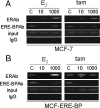Estradiol and tamoxifen mediate rescue of the dominant-negative effects of estrogen response element-binding protein in vivo and in vitro
- PMID: 19106221
- PMCID: PMC2671906
- DOI: 10.1210/en.2008-1148
Estradiol and tamoxifen mediate rescue of the dominant-negative effects of estrogen response element-binding protein in vivo and in vitro
Abstract
Biological responses to estrogens are dependent on the integrated actions of proteins, including the estrogen receptor (ER)-alpha, that regulate the transcription of estrogen response element (ERE)-containing target genes. We have identified a naturally occurring ERE antagonist, termed an ERE-binding protein (BP). To verify that ERE-BP can induce estradiol (E(2)) resistance in vivo, we generated transgenic mice that overexpress this protein in breast tissue. Female transgenic mice with high levels of ERE-BP were unable to lactate, and we hypothesized that this effect was dependent on the relative levels of ERE-BP and ERalpha ligand. To test this hypothesis, wild-type and ERE-BP-expressing female mice were implanted with capsules containing E(2), the selective estrogen receptor modulator tamoxifen, or placebo. Histological analysis of nonlactating mammary glands showed a 4.5-fold increase in gland branch number and 3.7-fold increase in ducts in ERE-BP mice treated with E(2) (7.5 mg, 21 d) compared with placebo-treated ERE-BP mice. Wild-type mice showed a 5.3-fold increase in branches and 1.4-fold increase in ducts under the same conditions. Similar results were obtained with tissue from lactating mice, in which tamoxifen also increased mammary gland branch number. Studies using ERE-BP-expressing MCF-7 breast cells showed that high doses of E(2) (1000 nM) restored normal ERalpha-chromatin interaction in these cells, whereas tamoxifen was able to achieve this effect at a dose of 10 nM. These data highlight the importance of ERE-BP as an attenuator of normal ERalpha signaling in vivo and further suggest that ERE-BP is a novel target for modulation by selective estrogen receptor modulators.
Figures






References
Publication types
MeSH terms
Substances
Grants and funding
LinkOut - more resources
Full Text Sources
Molecular Biology Databases

